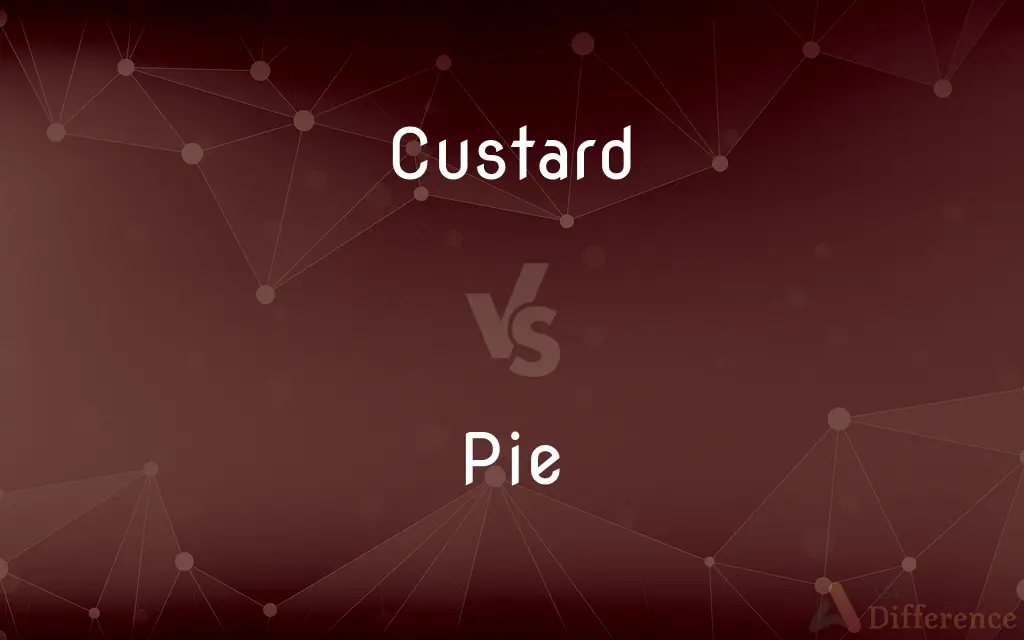Custard vs. Pie — What's the Difference?
By Fiza Rafique & Maham Liaqat — Updated on April 28, 2024
Custard is a sweet or savory dessert made primarily from milk or cream and eggs, thickened with heat, while pie is a baked dish featuring a filling encased in pastry or dough.

Difference Between Custard and Pie
Table of Contents
ADVERTISEMENT
Key Differences
Custard is a creamy mixture that can be either a dessert on its own or a component of other desserts, relying on eggs for thickening; whereas pie consists of filling, which can be sweet or savory, encased in a pastry shell that is baked.
Custards are typically smooth and thick, served chilled or at room temperature, while pies are usually served warm, especially when savory.
Custards require careful heat control to prevent curdling, while pies are baked in an oven, requiring a different kind of precision to achieve a flaky crust.
The primary flavor of custard comes from the richness of milk or cream and eggs, often enhanced with vanilla or other flavorings. In contrast, the taste of a pie largely depends on its filling, such as fruits, meats, or vegetables, complemented by the texture and flavor of its crust.
Both custard and pie can be integral to various cultural cuisines, often featured in traditional desserts or meals depending on regional preferences.
ADVERTISEMENT
Comparison Chart
Composition
Milk or cream and eggs thickened by heat
Filling encased in pastry or dough, then baked
Texture
Smooth and creamy
Varies from flaky crust to dense filling
Serving Temperature
Typically chilled or at room temperature
Often served warm, but varies with type
Preparation Focus
Heat control to prevent curdling
Baking technique to achieve desired crust texture
Flavor Influences
Richness of dairy, eggs; often vanilla-flavored
Depends on filling type: fruit, meat, vegetable, etc
Compare with Definitions
Custard
Often used as a filling or topping in various desserts.
The dessert featured a layer of smooth custard.
Pie
The crust can be flaky, crumbly, or pastry-like.
The key to a good pie is a perfectly flaky crust.
Custard
Served as part of many regional and traditional dishes.
Egg custard tarts are a popular treat in many parts of the world.
Pie
A baked dish with a filling encased in dough.
She baked an apple pie with a beautifully golden crust.
Custard
Can be flavored with a variety of ingredients.
Lemon custard is a refreshing variation of the classic dessert.
Pie
Can be sweet or savory, depending on the filling.
For dinner, we had a savory chicken pot pie.
Custard
A dessert made from milk or cream thickened with eggs.
The vanilla custard was silky and rich.
Pie
Varieties include open-top, double-crust, and filled.
Cherry pie is my favorite type of double-crust pie.
Custard
Requires gentle cooking to achieve its texture.
She stirred the custard slowly to prevent it from curdling.
Pie
Often associated with traditional meals and holidays.
Pumpkin pie is a staple at Thanksgiving dinners.
Custard
Custard is a variety of culinary preparations based on sweetened milk, cheese, or cream cooked with egg or egg yolk to thicken it, and sometimes also flour, corn starch, or gelatin. Depending on the recipe, custard may vary in consistency from a thin pouring sauce (crème anglaise) to the thick pastry cream (crème pâtissière) used to fill éclairs.
Pie
A pie is a baked dish which is usually made of a pastry dough casing that contains a filling of various sweet or savoury ingredients. Sweet pies may be filled with fruit (as in an apple pie), nuts (pecan pie), brown sugar (sugar pie), sweetened vegetables (rhubarb pie), or with thicker fillings based on eggs and dairy (as in custard pie and cream pie).
Custard
A dessert or sweet sauce made with milk and eggs, or milk and a proprietary powder.
Pie
A dish composed of fruit, meat, cheese, or other ingredients baked over, under, or surrounded by a crust of pastry or other dough.
Custard
A dish consisting of milk, eggs, flavoring, and sometimes sugar, boiled or baked until set.
Pie
A layer cake having cream, custard, or jelly filling.
Custard
A type of sauce made from milk and eggs (and usually sugar, and sometimes vanilla or other flavourings) and thickened by heat, served hot poured over desserts, as a filling for some pies and cakes, or cold and solidified; also used as a base for some savoury dishes, such as quiches, or eaten as a stand-alone dessert; egg custard.
Pie
(Informal) A pizza.
Custard
A mixture of milk and eggs, sweetened, and baked or boiled.
Pie
Something similar to or resembling pie
Mud pie.
Custard
Sweetened mixture of milk and eggs baked or boiled or frozen
Pie
A whole that can be portioned out
"That would ... enlarge the economic pie by making the most productive use of every investment dollar" (New York Times).
Pie
See magpie.
Pie
A former unit of currency of India.
Pie
An almanac of services used in the English church before the Reformation.
Pie
Variant of pi2.
Pie
A type of pastry that consists of an outer crust and a filling.
The family had steak and kidney pie for dinner and cherry pie for dessert.
Pie
Any of various other, non-pastry dishes that maintain the general concept of a shell with a filling.
Shepherd's pie is made of mince covered with mashed potato.
Pie
(Northeastern US) A pizza.
Pie
A paper plate covered in cream, shaving foam or custard that is thrown or rubbed in someone’s face for comical purposes, to raise money for charity, or as a form of political protest; a custard pie; a cream pie.
Pie
(figuratively) The whole of a wealth or resource, to be divided in parts.
Pie
(letterpress) A disorderly mess of spilt type.
Pie
(cricket) An especially badly bowled ball.
Pie
A pie chart.
Pie
(slang) The vulva.
Pie
(obsolete) Magpie.
Pie
(historical) The smallest unit of currency in South Asia, equivalent to 192 of a rupee or 12 of an anna.
Pie
(zoology) pie-dog: an Indian breed, a stray dog in Indian contexts.
Pie
(historical) A traditional Spanish unit of length, equivalent to about 27.9 cm.
Pie
(transitive) To hit in the face with a pie, either for comic effect or as a means of protest (see also pieing).
I'd like to see someone pie the chairman of the board.
Pie
(transitive) To go around (a corner) in a guarded manner.
Pie
(transitive) (of printing types) To reduce to confusion; to jumble.
Pie
An article of food consisting of paste baked with something in it or under it; as, chicken pie; venison pie; mince pie; apple pie; pumpkin pie.
Pie
A magpie.
Pie
The service book.
Pie
Type confusedly mixed. See Pi.
Pie
See Pi.
Pie
Dish baked in pastry-lined pan often with a pastry top
Pie
A prehistoric unrecorded language that was the ancestor of all Indo-European languages
Common Curiosities
How can you prevent a pie crust from getting soggy?
Pre-baking the crust or adding a layer of egg wash can help prevent it from becoming soggy from the filling.
How is custard used in other desserts?
Custard can be used as a layer in cakes, fillings for pastries, or as a base for ice cream.
What makes custard different from pudding?
Custard is egg-based and cooked with heat, often resulting in a creamy texture, whereas pudding typically includes starch and is denser.
What is the best way to serve custard?
Custard is best served chilled or at room temperature to enhance its texture and flavor.
Is custard always sweet?
No, custard can also be savory, such as in quiches or other baked egg-based dishes.
What are some common pie fillings?
Common pie fillings include fruits like apples and berries, meats like chicken or beef, and vegetables like pumpkin.
How do dietary restrictions affect making custard?
For those with dietary restrictions, custard can be made with non-dairy milks or egg alternatives.
Can pies be frozen for later use?
Yes, many pies can be frozen either before or after baking, making them convenient for later use.
What type of pie is most popular in the United States?
Apple pie is often cited as one of the most popular and iconic pies in the United States.
What are some traditional occasions for serving pie?
Pies are commonly served during holidays, family gatherings, and cultural events like Thanksgiving and Christmas.
Share Your Discovery

Previous Comparison
Dye vs. Stain
Next Comparison
Underweight vs. OverweightAuthor Spotlight
Written by
Fiza RafiqueFiza Rafique is a skilled content writer at AskDifference.com, where she meticulously refines and enhances written pieces. Drawing from her vast editorial expertise, Fiza ensures clarity, accuracy, and precision in every article. Passionate about language, she continually seeks to elevate the quality of content for readers worldwide.
Co-written by
Maham Liaqat















































